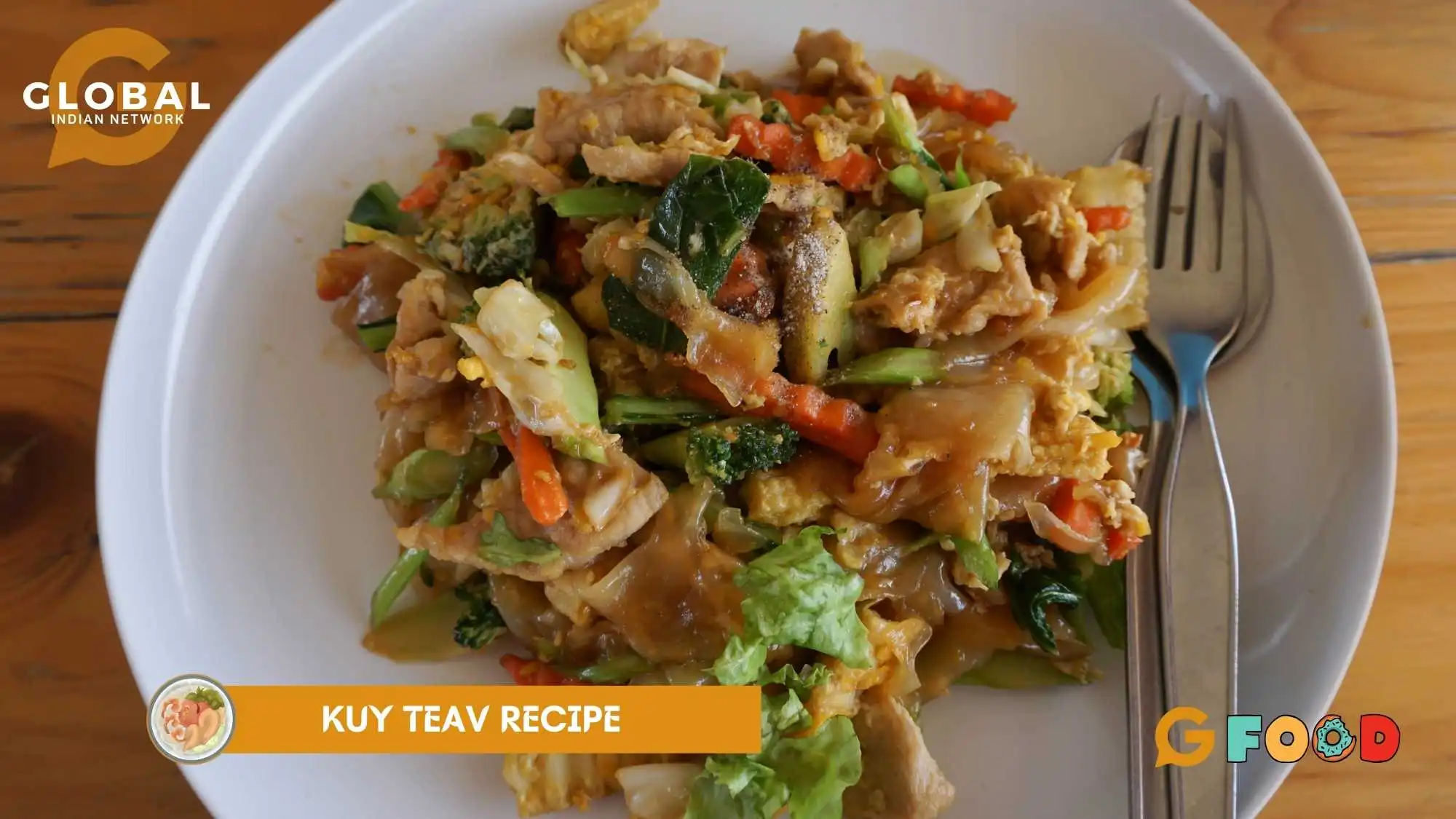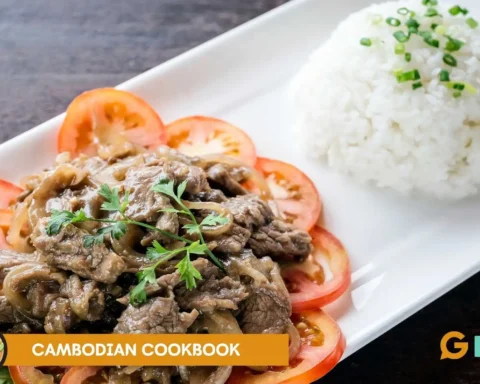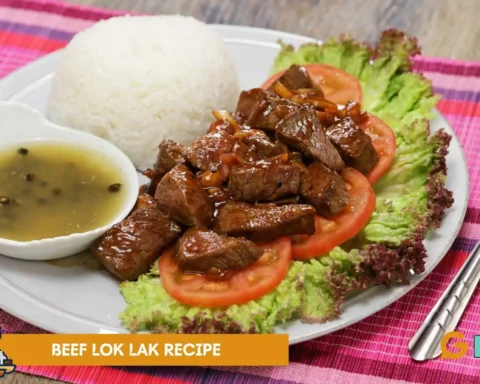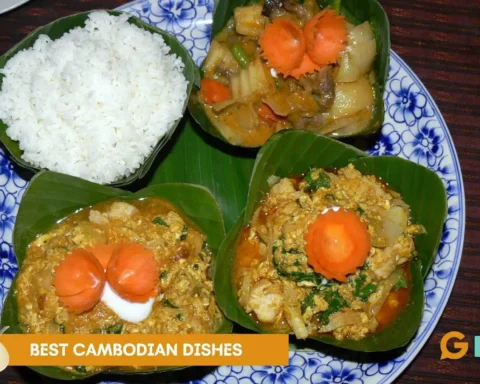Cambodian cuisine is greatly influenced by its neighbouring countries, one of which is Vietnam. Among its many delightful dishes, Kuy Teav stands out as a national favorite. It resembles the famous Vietnamese Pho noodles. This famous pork bone noodle soup is a comforting, delicious noodle soup that is both flavorful and deeply nourishing.
Often enjoyed for breakfast but satisfying any time of the day, the Kuy Teav recipe presents a culinary balance of sweet, salty, tangy, and umami typical of Southeast Asian cuisine. A hot pork broth simmering with pork bone, dried shrimps and squids, daikon radish, grilled onion, and spices is cooked for hours overnight to bring the best flavor for the morning breakfast.
Table of Contents
What is Kuy Teav?
Kuy Teav is a traditional Cambodian noodle soup made with a clear pork or beef broth, rice noodles, and a variety of toppings such as sliced meat, bean sprouts, herbs, and fried garlic. Its origins trace back to Chinese immigrants who introduced noodle dishes to Cambodia, which were then adapted to local tastes and ingredients. Over time, Kuy Teav evolved into a uniquely Cambodian dish, often served in street food stalls or family kitchens across the country.
Each region and even each household may have its own version of the Kuy Teav recipe, making it a highly versatile and personal dish. Some prefer it light and brothy, others rich and hearty with added beef balls, intestines, or shrimp. Families bond over steaming bowls, adding their favourite toppings and adjusting the flavors to personal taste. No matter the variation, it remains a beloved staple.
Essential Ingredients for the Kuy Teav Recipe
Before you start cooking, gather the following array of ingredients for a classic pork-based Kuy Teav recipe:
Broth ingredients:
- 2 lbs pork bones
- 2 liters of water
- 1 grill onion, halved
- 4 cloves garlic, smashed
- 2 tablespoons fish sauce
- 1 tablespoon sugar
- Additional salt to taste
- Dried squid or dried shrimp for added umami (optional)
Ingredients for toppings:
- 300g pork shoulder or ground pork
- 200g fresh rice noodles (thin or medium)
- Bean sprouts (blanched)
- Fried garlic
- Chopped green scallions
- Fresh cilantro
- Lime wedges
- Hot chili sauce, thinly sliced red chilies, or chilli flakes
- Soy sauce, sriracha sauce, and hoisin sauce (for table seasoning)

Step-by-Step Cooking Ingredients
Start by preparing a clear, flavorful hot soup broth. Blanch the pork bones in boiling water for 5 minutes to remove impurities. Drain, rinse the bones, and refill a pot with 2 litres of fresh water. Add the bones, green onion, crispy garlic, and optional dried squid or shrimp. Bring to a boil, then reduce to a simmer at medium heat for 1.5 to 2 hours, skimming off any foam that rises. Season with salt, fish sauce, and sugar. Strain the broth through a fine-mesh strainer to remove solids and set aside.
Slice the pork shoulder thinly or cook the ground pork in a pan with a pinch of salt and black pepper. Some prefer boiling thin pork slices directly in the broth to keep them tender. Cook the rice noodles according to the package instructions. Drain and rinse them under cold water to prevent sticking.
Place a portion of fresh noodles in a serving soup bowl, followed by slices of pork or spoonfuls of cooked ground meat. Add a handful of blanched bean sprouts, a sprinkle of chopped scallions, and fresh cilantro. Pour hot broth over the noodle bowl. Garnish with bean sprouts, a squeeze of lime juice, or fried garlic cloves and serve with condiments like lime wedges, hoisin sauce, and chili paste.
Tips to Perfect Your Kuy Teav
The heart of the Kuy Teav recipe is a clear, well-seasoned broth. Simmer slowly and patiently in warm water, and do not skip the step of blanching bones; it makes all the difference in clarity and flavor. A garnish of scallions and cilantro adds brightness. Always use fresh herbs for best results.
From poached eggs to shrimp balls, Keiv Teav is endlessly customizable with an abundance of ingredients. Use what you have and what you love. Some families like adding pickled vegetables, additional bean sprouts, coriander seeds, coriander stalks, or garlic vinegar for extra zing. Try different condiments and find your signature style.
Conclusion
This Cambodian breakfast noodle soup is the perfect dish to start your journey into Cambodian cuisine. One of the most beloved street food dishes, it captures the soul of a culture that values freshness, balance, and community. As you master the Kuy Teav recipe, you are embracing centuries of tradition and sharing a piece of Cambodia’s culinary heart.
Known as a dish created by Cambodians of Teochew Chinese descent and enthusiastically adopted by pretty much everyone, Kuy Teav takes a lot of time, patience, and getting the right ingredients to cook the perfect broth. Whether making it for a quiet breakfast or serving it to friends and family, this Cambodian food brings people together with every fragrant bowl.

FAQs
What is Kuy Teav made of?
Kuy Teav is made of a clear pork or beef broth served with rice noodles and topped with ingredients like sliced pork, bean sprouts, fried garlic, scallions, and aromatic herbs. It is often garnished with lime, chili, and various sauces for added flavor.
What does kuy teav taste like?
Kuy Teav has a light, savory broth with subtle sweetness and umami from pork bones, fish sauce, and aromatics. The fragrant herbs, lime, and chili add brightness and a gentle kick, making each spoonful flavorful and balanced.
What is Khmer pho called?
Khmer pho is also known as Kuy Teav or Phnom Penh noodle soup in Cambodia. It’s a popular Cambodian-Chinese noodle soup made with a clear pork or beef broth, rice noodles, and various toppings like sliced meat, bean sprouts, and herbs.









